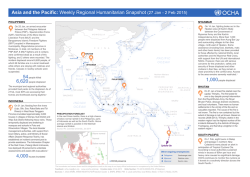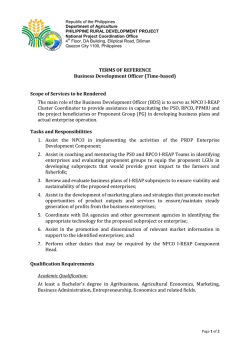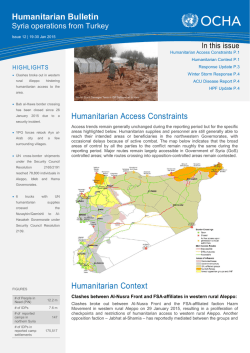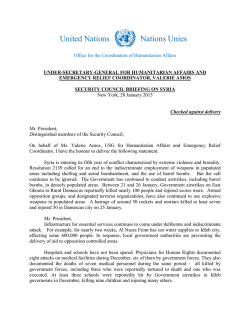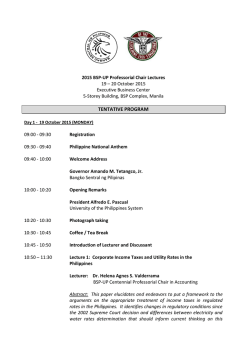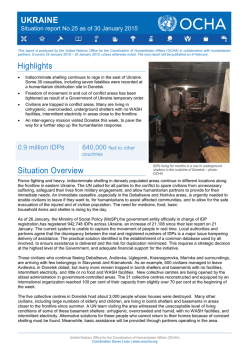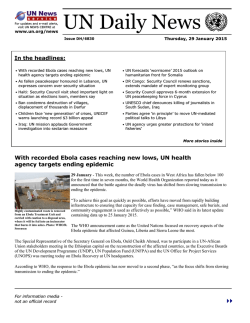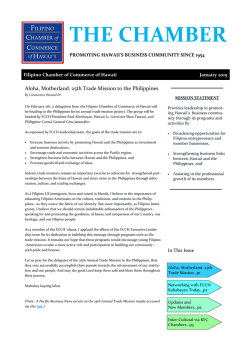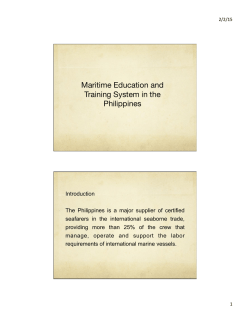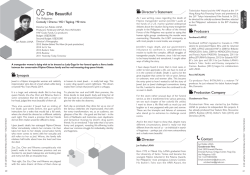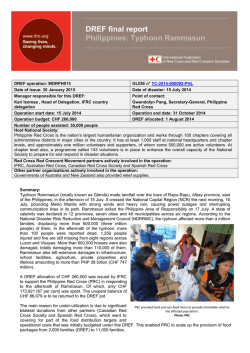
Download PDF (547.47 KB)
Humanitarian Bulletin Philippines Issue 1 | 1 – 30 January 2015 In this issue Challenges of IDPs in Zamboanga P.1 2014 Typhoon Season P.2 HIGHLIGHTS Mayon Volcano alert level lowered P.4 • 20,000 people still remain in transitional shelters in Zamboanga – a 14 per cent Credit: OCHA/Alkhaulan Hashim decline in the last three months. • 19 tropical storms affected the Philippines in 2014; the storm season was less active than the previous year. • The Government focuses on disaster preparedness, calling for a “whole-of-society approach”. • Evacuation orders lifted as the Mayon Volcano alert Displaced communities in Zamboanga still beset by challenges Sixteen months after the “Zamboanga Siege” – a violent clash between a faction of Moro National Liberation Front and the Philippine government forces that killed at least 140 and uprooted 120,000 people – almost 20,000 people remain in temporary shelters, struggling to make ends meet. Under the Zamboanga City Roadmap to Recovery and Reconstruction (Z3R), authorities plan to provide permanent housing units for about 7,000 displaced families (35,000 people) by June 2015. In the meantime, displaced families are being transferred from the largest remaining evacuation centre in the Grand Stand Sports Complex, where some 7,200 people remain, to transitional sites like Masepla. level is lowered. • The Government invests in long-term solutions to resettle those regularly exposed to the threat of volcano eruption. FIGURES Zamboanga Crisis # of IDPs in evacuation centres # of IDPs in transitional sites 7,335 12,576 Source: CCCM, 19 January 2015 From Grand Stand Evacuation Centre to Masepla Transitional Site Passing through the boardwalk connecting bunkhouses in Masepla transitional site, Ernesto Manias’ small sari-sari stand is neatly set up in front of the family unit. He has an array of goods on display such as cassava, charcoal and instant coffee packs. “I was a vendor before the siege. I used to sell flashlights and electronic gadgets along busy sidewalks in order to send my kids to school,” says Ernesto. Ernesto, his wife Delma and four children are among the 4,700 displaced people living in Masepla, waiting for the construction of permanent housing. The family abandoned their home in Rio Hondo, a coastal neighborhood next to the city’s main port, when the fighting broke out in September 2013. They drifted from place to place until they were left with no choice but to move to the Cawa-Cawa shoreline evacuation site in order to receive emergency shelter, food packs, and other basic life needs provided by the government and humanitarian agencies. They lived there for seven months before eventually being moved to Masepla in August 2014. “Although we have more privacy and better protection against rains here than in Cawa-Cawa, the cost of transportation from here to the downtown area and problems with water supply is hard on us,” says Ernesto. The 8 km distance from Masepla to the city centre makes it difficult for the people to earn income, as many of their livelihoods before the siege depended on fishery and trading. To save the cost of commuting, Ernesto reduced his trips to sell goods in the city centre and instead put up a sari-sari store, Credit: OCHA/Alkhaulan Hasim Zamboanga, (Jan 2015) - Ernesto Manias sells cassava in front of his bunkhouse room in Masepla transitional site. Philippines Humanitarian Bulletin | 2 Out of some 1,200 school-aged children, almost half are not attending school due to either lack of funds or because they have to work to support the family. where he sells cassavas for PhP160 (US$4) each with PhP40 ($1) revenue. The unpaved road to Masepla results in irregular fresh water delivery. The limited water supply aggravates the poor sanitation and hygiene condition, exposing the already vulnerable community, especially children and the elderly, to greater health and protection risks. Since September 2013, 219 people – nearly half of them children below five years old – have died in evacuation centres and transitional sites in Zamboanga. Struggling to make ends meet Ernesto and Delma also face the challenge of obtaining birth certificates for their children. “We cannot afford to pay for these important civil documents on top of the daily needs of our family. This small retail store barely keeps our children in school. We have to save at least PhP86 ($2) daily to cover our children’s transport fare to school and back,” Delma shared, holding back her tears. Birth certificates cost PhP330 ($7.50) each. Credit: OCHA/Alkhaulan Hasim Zamboanga (Jan 2015) Jihad (10), Sandigoy (13), and Jainal (8) showing pieces of wire they gathered to sell. Two doors down from Ernesto’s sari-sari store, gather three children, peeling off the coating of discarded electric wires with their teeth and hands. Ten-year-old Jihad, his eight-year-old brother, Jainal, and 13-yearold friend, Sandigoy, collect pieces of rusty iron nails, metal scraps and electric wires. The children sell these to earn money to go to school located 10 km away. “We go to the Central School. It is very far from here,” says Jainal. “We need to make 50 pesos ($1.20) everyday so that we can go to school and back.” Their mother works as a laundrywoman to support the family. “Our mother is out there to fetch water for us and we are collecting these wires to sell in order to help her,” says Jihad, pointing to the far end of the boardwalk where empty jelly bottles and buckets are piled up, waiting for the next delivery of water. Out of some 1,200 school-aged children in Masepla, almost half are not attending school, either due to lack of funds or because they have to work to support the family. To fulfill the displaced people’s right to a sustainable future Ernesto said his little neighbors have a more challenging life than his family. Delma says her family still wants to go back to Rio Hondo. “It’s near the city centre and the cost of transportation would be only 6 pesos ($0.15). There, we can easily find work.” The neighbor kids echoed her wish, “We want to go back there because we miss playing with our other friends.” Without sustained support to address the residual humanitarian concerns at the transitional sites, fragile living conditions of people like Ernesto and Jihad may deteriorate rather than improve. The total population in Masepla may exceed 10,000 with more people expected to join from the Grand Stand in the coming weeks. As priority shifts to recovery and long-term solutions for the displaced, humanitarian partners assisting the communities are at a critical juncture to channel resources to improve the conditions of those who remain displaced as well as to advocate affected peoples’ right to a sustainable future. 2014 Typhoon Season in the Philippines A total of 19 tropical storms entered the Philippine Area of Responsibility (PAR) in 2014, starting with Tropical Storm Agaton (internationally known as Lingling) in January and ending with Tropical Storm Seniang (Jangmi) in December. The year was not as active as 2013 when 26 storms, including the Super Typhoon Yolanda (Haiyan), battered the country. Typhoon Ruby (Hagupit) that struck in December was the most powerful of them http://philippines.humanitarianresponse.info | www.unocha.org/philippines United Nations Office for the Coordination of Humanitarian Affairs (OCHA) • Coordination Saves Lives Philippines Humanitarian Bulletin | 3 The Government’s disaster risk reduction and management Strategy increases focus on preparedness. Summary of the impact of major tropical cyclones that affected the Philippines in 2014 Typhoon Glenda (Ramassun) Typhoon Ruby (Hagupit) Tropical Storm Seniang (Jangmi) Duration in PAR 13-17 July 2014 (5 days) 4-10 December 2014 (7 days) 28 December 2014 – 2 January 2015 (6 days) Maximum sustained winds 150 kph 215 kph 65 kph Up to 180 kph Up to 250 kph Up to 80 kph Floods and landslides Floods and storm surges Floods and landslides 4.7 million people 106 dead 1,250 injured 5 missing 3.5 million people 18 dead 916 injuries 579,000 people 66 dead 43 injured 6 missing Damaged houses 633,700 houses 290,670 houses 3,300 houses Estimated damage PhP38.6 billion ($874 million) PhP5 billion ($100 million) PhP1.2 billion ($26 million) Immediate relief provided PhP69 million ($1.5 million) PhP248 million ($5.5 million) PhP36.3 million ($806,000) Affected regions I, III, IV-A, IV-B, V, VII and Metro Manila III, IV-A, IV-B, V, VI, VII, VIII and Metro Manila IV-B, VI, VII, VIII, IX, X, XI and CARAGA Gusts Hazards Affected people Source: NDRRMC, PAGASA all, according to the Philippine Atmospheric, Geophysical and Astronomical Services Administration (PAGASA). It closely followed the track of Typhoon Yolanda, bringing back haunting memories of the unprecedented devastation that was caused to those in the storm’s path. “Whole-of-society” approach to disaster preparedness and response Many of the lessons from the Typhoon Yolanda experience were applied at all levels in 2014 with the government calling for a “whole-of-society” approach to disaster preparedness and response. One of the largest ever preemptive evacuations was orchestrated as Typhoon Ruby approached the country, saving many lives. More than 1 million people (230,600 families) evacuated to safer locations. With the devastation of Typhoon Yolanda fresh in mind and prompted by the government’s massive awareness campaigns, people evacuated voluntarily. Social media was used to gather and disseminate information for early warning and early action. The government also institutionalized procedures for a pre-disaster risk assessment that Tracks of major tropical cyclones that affected the Philippines in 2014 West Philippines Sea Philippines Sea Metro Manila Typ hoo nY Typho on Ru b y(H ag upi t)-D ec Tro pic al S tor m Glend a(Ram m em be r asun)Ju ly Tacloban Cebu Sen ian g(Ja n gm i)-D ec em ber Sulu Sea Davao Source: GADM, OCD, PAGASA http://philippines.humanitarianresponse.info | www.unocha.org/philippines United Nations Office for the Coordination of Humanitarian Affairs (OCHA) • Coordination Saves Lives Philippines Humanitarian Bulletin | 4 determines preparedness measures to be carried out by national, regional and local agencies. To enhance accountability and transparency, humanitarian organizations were encouraged to coordinate with the National Disaster Risk Reduction and Management Council (NDRRMC) and with appropriate government clusters through a newly established registry. The government’s disaster risk reduction and management strategy is squarely focused on preparedness. With up to eight storms expected to affect the Philippines between February and July this year, the challenge is to sustain best practices and further enhance systems and procedures to ensure lives are saved in the next disaster. Long-term solution for the threat of volcano eruption Affected communities of Mayon volcano remain vigilant despite the lowered alert level. Evacuation orders lifted as volcano’s alert level is lowered The Philippine Institute of Volcanology and Seismology (PHIVOLCS) lowered the alert level of the Mayon Volcano from level 3 to 2 on 19 December 2014, indicating that the likelihood of a hazardous eruption within weeks has lessened. In response, the Albay Provincial Disaster Risk Reduction and Management Council (PDRRMC) lifted all evacuation orders for the remaining evacuees. While about 3,000 families (15,000 people) were allowed to return home, the residents in the vicinity of the volcano continue to be reminded to take precautionary measures. They should be prepared to preemptively evacuate when the alert level is raised and be mindful of the revised danger zone markings set by PHIVOLCS in November last year. Progress in the resettlement of people living in permanent danger zones The Albay provincial government began constructing permanent relocation sites for more than 3,000 families residing within the 6-km permanent danger zone (PDZ) as part of a long-term solution for those who have had to evacuate whenever volcano’s alert level was raised. The provincial government is allocating at least PhP360 million ($8 million) to resettle those in the 6-km PDZ, which includes the city of Tabaco and municipalities of Malilipot, Camalig and Guinobatan. An additional PhP6 billion ($136 million) is needed to resettle 4,400 families residing in the 8-km extended PDZ. The provincial government is investing in the relocation plan formulated in November 2014 to pursue its zero-casualty goal and ensure the safety of families in the PDZs. For further information, please contact: Mark Bidder, Deputy Head of Office, [email protected], Tel. (+63) 917-524-2928 Catherine Alcaraz, Humanitarian Affairs Analyst – Public Information, [email protected], Tel. (+63) 927-554-6155 OCHA humanitarian bulletins are available at http://philippines.humanitarianresponse.info | www.unocha.org | www.reliefweb.int http://philippines.humanitarianresponse.info | www.unocha.org/philippines United Nations Office for the Coordination of Humanitarian Affairs (OCHA) • Coordination Saves Lives
© Copyright 2026
